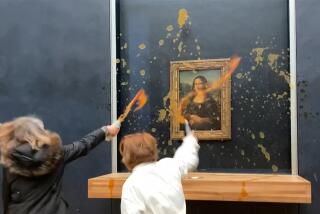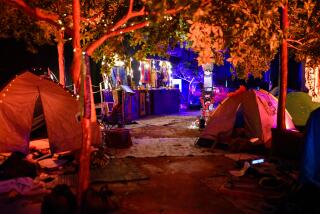NEA and the Arts: The Turmoil Continues : ART REVIEW : ‘Witnesses’ Show Presents AIDS as a Complex Issue
- Share via
NEW YORK — “Witnesses: Against Our Vanishing,” a modest and touching exhibition about AIDS at Artists Space, has been catapulted into the national spotlight by a raging controversy over government support of the arts.
This may be a very good thing--coming, as it does, on the heels of a record auction season. The clamor will surely draw crowds to an exhibition that would get little notice under calmer conditions. If nothing else, visitors will see that art can be more than a commodity. It can also be an expression of profound emotion, created from experience with no thought of profit.
The exhibition, which opens here tonight and runs through Jan. 6 at the gallery in Manhattan’s TriBeCa district, was organized by photographer Nan Goldin, who confronted the devastation of AIDS when she tried to reconnect with old friends after she recovered from drug addiction.
Goldin originally conceived of a more celebrity show than the one that developed. But the reality of death in her artistic community changed her vision from one that was essentially life-affirming to a more sober examination of vulnerability and loss. Theory gave way to personal experience as she enlisted works from artists who had lived and worked on Manhattan’s Lower East Side.
In the catalogue essay, Goldin says she views the exhibition not as “a definitive statement about the state of art in the era of AIDS but as a vehicle to explore the effects of the plague on one group of artists in a way that hopefully will speak to all survivors of this crisis.”
The result is typical of theme shows often staged in such “alternative spaces” --noncommercial galleries that struggle along on low budgets but often manage to pull off significant projects.
What we see in “Witnesses: Against Our Vanishing” is a varied array of works--photographs, paintings and sculptures in assorted media--linked by a social issue. Some of the works are so abstract or oblique in their references to AIDS that an unwitting observer might miss the connection. Other images confront sexuality and disease directly.
This mixed bag of art is aesthetically incoherent--and purposefully so. The idea was for artists of different sensibilities to respond to the theme, either through works they had already made or by creating pieces specifically for the exhibition. Some didn’t live long enough to see the show, others are sick and still others are physically healthy but emotionally wounded.
The late Vittorio Scarpati contemplated death with agonizingly imaginative clarity in a series of ink drawings done in his hospital bed. Wiry angels, mortals and dissected bodies limned on sketch book pages surround a juicy red drawing of a heart, rather like petals of a flower, in a display of his work.
Painter James Nares has charted “Heartbeats” as wavy ribbons of pigment on canvas and paired them with depictions of ordinary people pushing shopping carts or congregating on street corners. The rhythm of their collective heart is writ large while their bodies blend into crowds.
Homosexuality is a theme of some of the work but never the whole story. Allen Frame’s casual photos of gay people talk about long-term friendships, for example, while David Armstrong’s photographs are probing portraits of individuals.
Dorit Cypis has bared her body and soul in a series of small photographic self-portraits set on shelves. Their clarity contrasts sharply with a large, shadowy photograph of a reclining woman, framed (or entombed?) above the shelves. This would be an intriguing treatment of human vulnerability in any exhibition; in the context of AIDS, the piece, called “Yield,” presents the body as a highly problematic container that can be diseased and lost while the mind watches.
Another effective group of works, Shelburne Thurber’s color photographs of empty, mundane bedrooms, evokes betrayed secrets and a sense of loss.
Other approaches to a troubling theme are Tom Chesley’s gritty paintings of drifting cages, bridges and hospitals; Ken Tisa’s paintings of isolated figures searching for their spirits and Greer Lankton’s sculptural “Skins,” portrayed as broken shells of bodies.
There is an undeniable message here, and it is political to the extent that it questions a power structure that has been slow to take AIDS seriously. But there is no sloganeering and there is nothing that suggests easy answers. Art is not proposed as a solution, only a way of examining feelings and issues as artist have done through the ages.
Perhaps the best aspect of “Witnesses” is that it presents AIDS as a complex issue that elicits a wide range of responses. Rage, denial, grief and transcendence are all filtered through the artists’ perceptions and made visual.
BACKGROUNDThe AIDS exhibit at Artists Space was originally supported by a $10,000 grant from the National Endowment for the Arts. The grant was withdrawn Nov. 8 in the wake of the controversyNEA’s funding of allegedly obscene photographs. Endowment chairman John E. Frohnmayer’s explanation of the action cited the politically charged nature of the exhibit; this raised concerns that a new Endowment provision aimed at denying federal funds to artwork judged obscene will be broadened to effect political censorship.
More to Read
The biggest entertainment stories
Get our big stories about Hollywood, film, television, music, arts, culture and more right in your inbox as soon as they publish.
You may occasionally receive promotional content from the Los Angeles Times.










